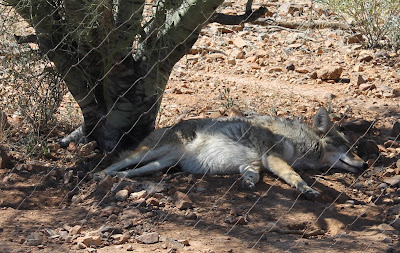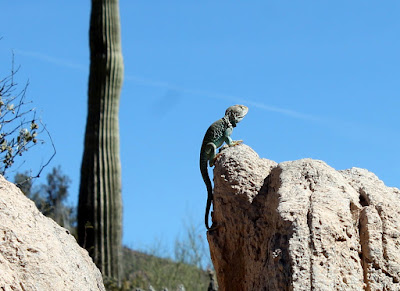We had another great week in Tucson. The weather has really warmed up with highs near 90. Even with those high temperatures during the day it really cools off at night, sometimes by as much as 35 degrees. Most mornings we start out with long sleeves, change to a t-shirt by 10 AM and then back to long sleeves in the evening. One thing I like about places with higher humidity is the low temps are usually within five or ten degrees of the high. We have been exercising earlier in the day to beat the heat.
We had a few days with some high thin clouds so there has been some great sunsets. Our view looking out our big picture window - windshield.
We finally took advantage of the Santa Cruz River Bikeway. We rode nearly 20 miles on this beautifully paved trail. When complete it will be a loop over 100 miles long.
The Tra-Tel RV Park is in the background on the other side of the "river". To friends from parts of the country where rivers actually have water in them this does not look like much, but I guess during the monsoon season there is water.
Another morning during our walk we ran into Heather and Craig who we meet at Betty's RV Park. They are not full timers but do spend several months a year on the road. It was a quick visit, but it is always great seeing friends when we travel.
One of the neatest things about Arizona is the saguaro cactus. While you see them as part of landscaping in many places, they only grow in the wild in a very narrow band. In Tucson you have to get a bit higher in elevation to see them. Often where they grow there will be thousands of them. They do have a human look about them.
We went to the Arizona-Sonora Desert Museum with Allan and Sharon for the opening of the Pastel Association exhibit. We only got to see a small part of the 98 acre facility. It includes a museum, botanical garden, and aquarium in addition to the art galleries. Here are a few pictures of the many animals, some that I don't remember what they are, and landscapes.
In the scorpion display they have a button to turn on a black light so they glow.
One of many species of tarantulas, this one is very colorful.
A handler with a kestrel. We have seen many of these raptures during our morning walks.
Part of the cave exhibit includes a section about bats. I my have to get a pair of these bat ears because I sure could hear a lot better. That would make Nanc really happy.
Arizona has a huge number of different minerals. This is just a small part of that exhibit in the cave.
It was hot the day we were there and we were surprised how active many of the animals were. The mountain lion was roaming around its pen. They don't have one here but we saw on TV that they have spotted at least three jaguars in the southern part of the state. The wall will be stopping these illegal border crossings.
The Black Bear was having a great time cooling off in the water.
A pair of wolves escaping the direct sunshine and afternoon heat.
The coyote was fast asleep and trying to stay cool.
None of the javelinas were moving. We saw a couple and they were both hiding in the shade.
The chuckwalla is an animal that loves the heat. They are active at temperatures up to 102 degrees. This one was loving the heat.
A bobcat was holed up in a small box cage.
The frogs were in full spring time mode.
This is the only way I want to see a rattlesnake. They have many different species of rattlers. This one was extremely active. We sure were happy it was behind glass.
If you have Wile E Coyotes you have to have roadrunners. We often see them on our walks.
No this is not a two headed snake, it is two coiled together.
While they are not native to the Sonoran Desert the prairie dogs are always popular.
Here are several pictures of the many cacti and desert plants in full bloom.
While the desert blooms do not cover the ground like spring plants in wetter environments, there is still a variety of colors.
The Sonoran Desert has one of the greatest variety of plants of any arid environment.
There is also a very large variety of bees that pollinate the many plants.
One blooming and one dead century plant. These plants are part of the agave family and only bloom once. While it takes a long time to bloom, 20 to 30 years, it does not take a century.
It is neat seeing so many different desert plants all together.
Many of the plants here are meant to attract bees and butterflies.
The otter was in almost constant motion. You can view them underwater or from above.
The sheep seem to like the shade over the sun.
While it is a zoo, wild animals are on the grounds. This guy was eating the leaves off the plant. We didn't mind seeing him but we sure were glad we did not see any snakes.
We had visited the hummingbird garden when we were here last month, but were told we should check it out again because the were mating. Here is one on a nest. Their eggs are the size of a small jellybean.
The desert museum is a worthwhile stop if you want to get up close with a large variety of desert plants and animals.





































2 comments:
We love visiting there and you can keep going back and see different things.
Love the ears, great post.
Post a Comment